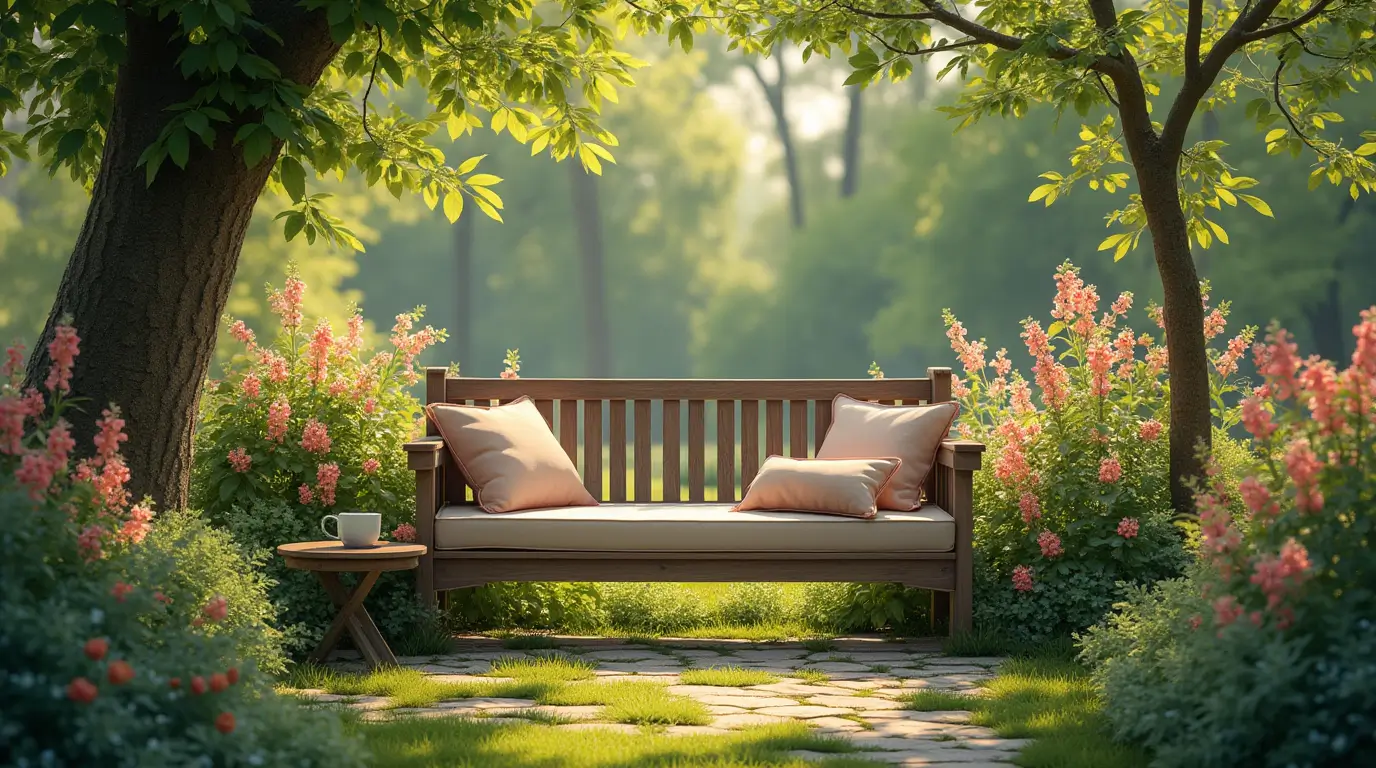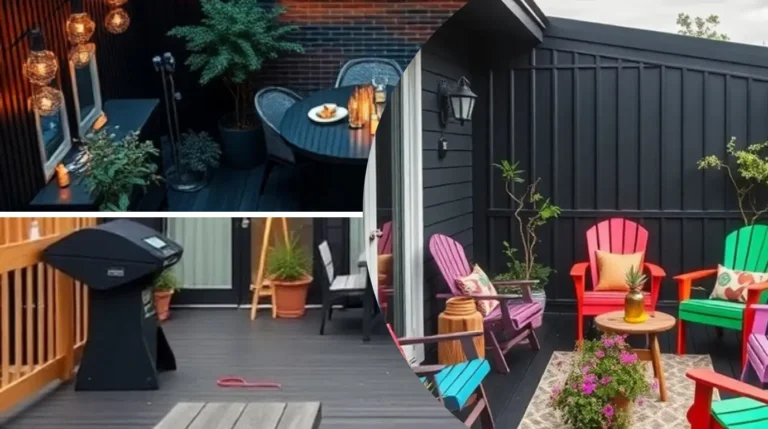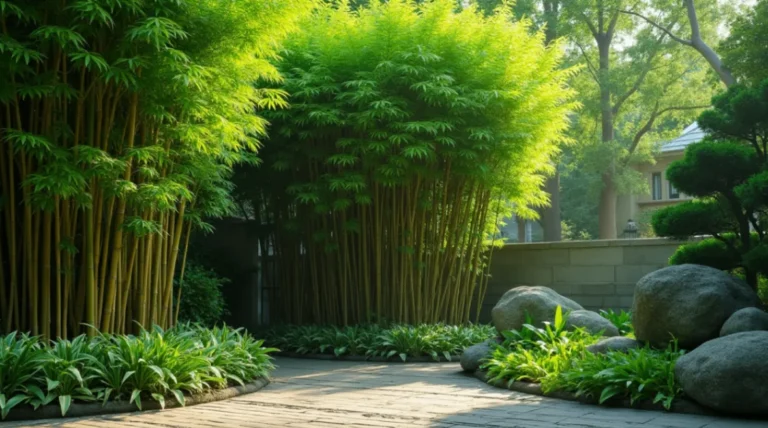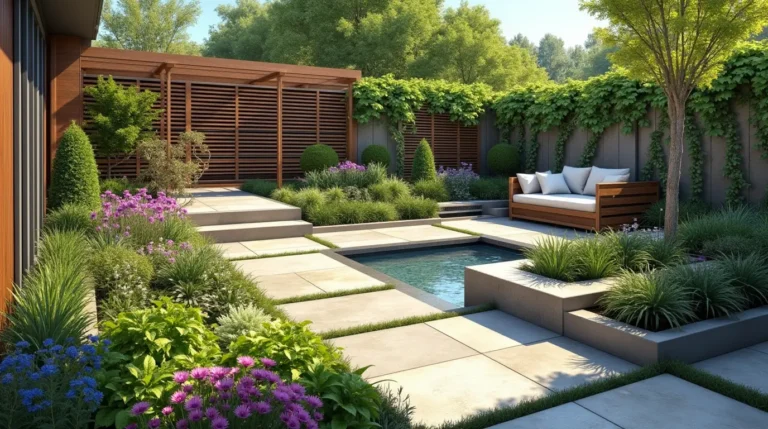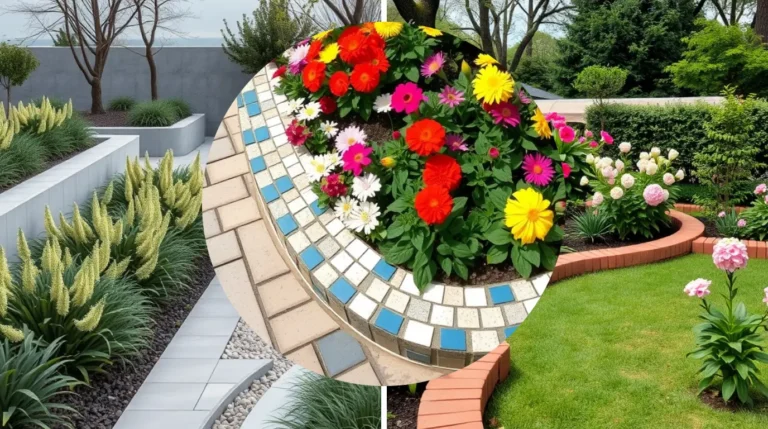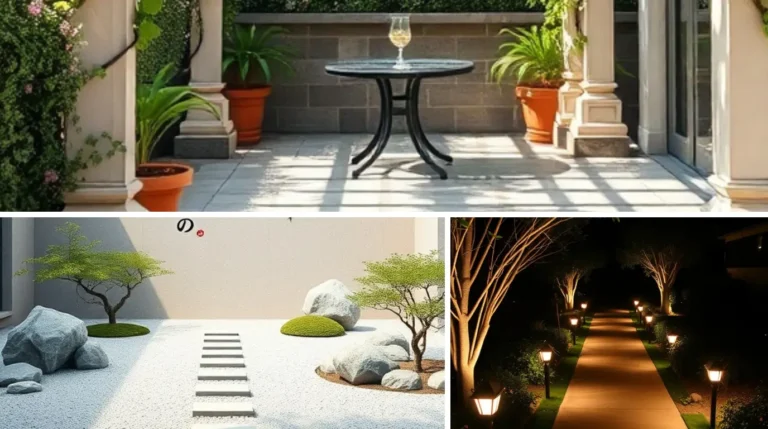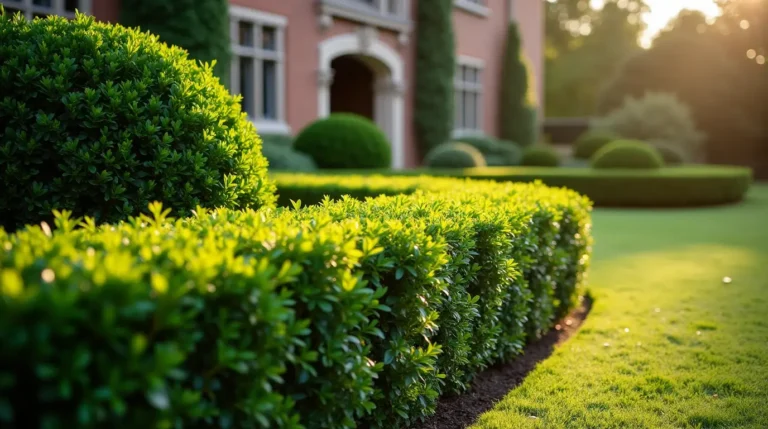Garden Bench: Make Your Garden The Ultimate Relaxation Spot
Introduction
Imagine stepping into your garden, surrounded by lush greenery and the gentle hum of nature, only to find the perfect spot to sit, relax, and unwind. A garden bench is more than just a piece of outdoor furniture—it’s the key to transforming your garden into the ultimate relaxation spot. Whether you’re looking to create a cozy nook for morning coffee, a serene retreat for evening meditation, or a charming space to entertain guests, a well-chosen garden bench can elevate your outdoor experience. In this blog post, we’ll explore how to select, style, and maintain the perfect garden bench to turn your garden into a haven of comfort and tranquility. Let’s dive in!
1. Why a Garden Bench is Essential for Your Outdoor Space
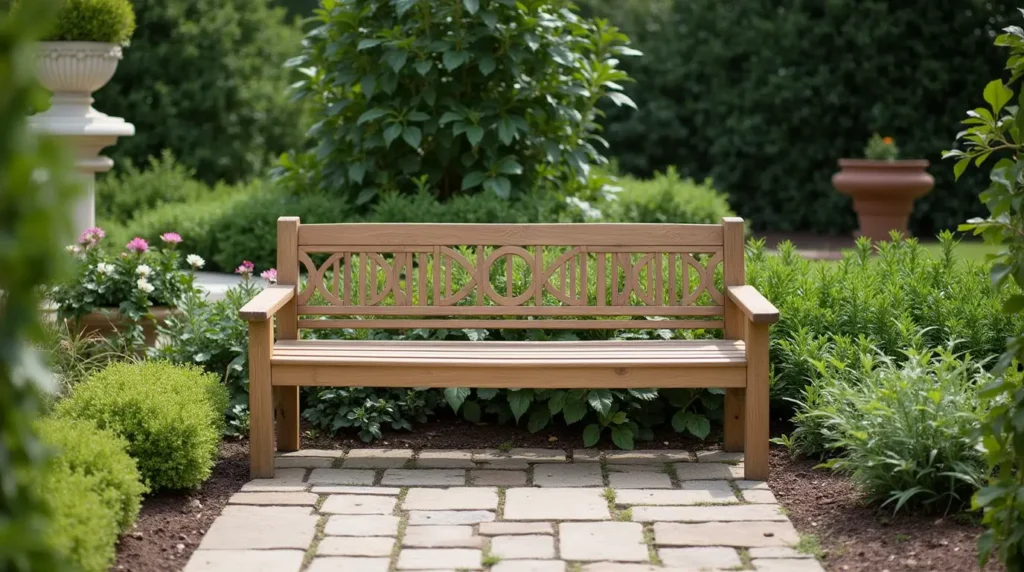
1.1. A Garden Bench Adds Aesthetic Appeal to Your Garden
A garden bench isn’t just a functional piece of furniture—it’s a statement piece that can elevate the visual appeal of your outdoor space. Whether you choose a sleek modern design, a rustic wooden bench, or a vintage wrought iron style, a well-placed bench can serve as the focal point of your garden, it complements your landscaping, ties together different elements of your outdoor decor, and creates a sense of harmony. Imagine a charming bench nestled among blooming flowers or under a shady tree—it instantly transforms your garden into a picturesque retreat.
1.2. Create a Functional Relaxation Spot
One of the primary reasons to invest in a garden bench is to create a dedicated space for relaxation. In today’s fast-paced world, having a quiet spot to unwind is more important than ever. A garden bench provides the perfect place to sit back, breathe in the fresh air, and enjoy the beauty of nature. Whether you’re reading a book, sipping your morning coffee, or simply soaking up the sun, a bench offers a comfortable and inviting space to pause and recharge. It’s your personal sanctuary right in your backyard.
1.3. Versatility for Socializing and Entertaining
A garden bench isn’t just for solo relaxation—it’s also a versatile piece of furniture for socializing and entertaining. It’s the ideal spot for intimate conversations with friends, family gatherings, or even outdoor dining. Pair it with a small side table, and you’ve got the perfect setup for a cozy evening with loved ones. Whether you’re hosting a summer barbecue or enjoying a quiet moment with a partner, a garden bench enhances the functionality of your outdoor space.
1.4. Boost Your Property’s Value and Appeal
Did you know that a well-designed outdoor space can increase your property’s value? A garden bench is a simple yet effective way to enhance your home’s curb appeal. It adds a touch of elegance and functionality that potential buyers or visitors will appreciate. Even if you’re not planning to sell your home, a beautiful garden bench makes your outdoor space more inviting and enjoyable for everyone. It’s a worthwhile investment that delivers both comfort and lasting value.
2. How to Choose the Perfect Garden Bench for Your Needs
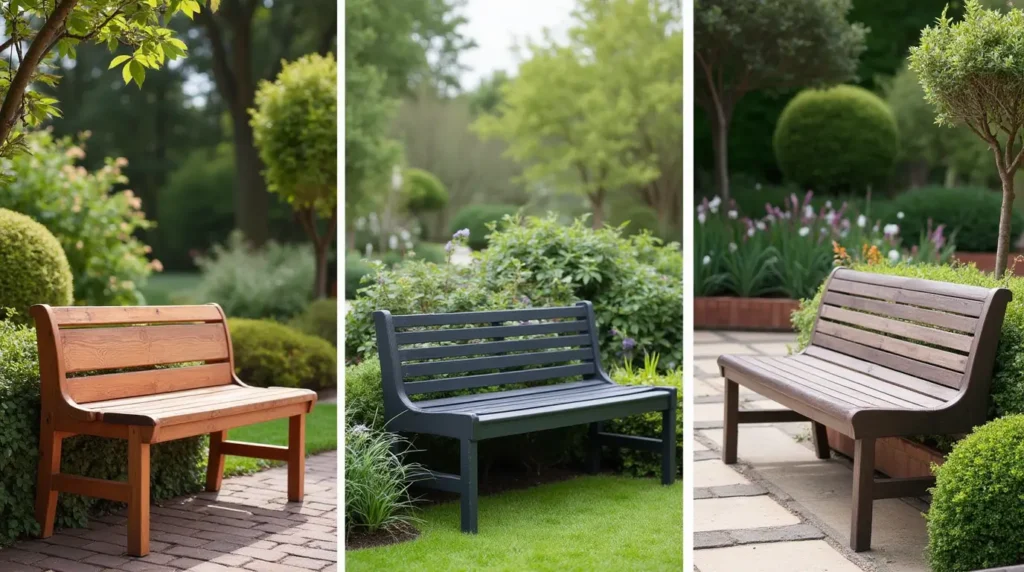
2.1. Consider the Material: Durability Meets Style
The type of material used for your garden bench significantly impacts its longevity, upkeep requirements, and overall visual appeal. Here’s a quick breakdown of popular options:
- Wood: Offers a classic, natural look. Teak and cedar are highly durable and weather-resistant, while pine is more affordable but may require regular maintenance.
- Metal: Wrought iron or steel benches are sturdy and long-lasting, often featuring intricate designs. However, they can get hot in the sun and may rust over time if not properly treated.
- Recycled Plastic: Eco-friendly, low-maintenance, and resistant to weather damage. Perfect for modern gardens but may lack the charm of natural materials.
- Concrete: Extremely durable and ideal for a minimalist or industrial look, but heavy and difficult to move.
Choose a material that aligns with your garden’s style, climate, and maintenance preferences.
2.2. Match the Style to Your Garden’s Theme
Your garden bench should complement the overall theme of your outdoor space. Here are some popular styles to consider:
- Modern: Sleek, minimalist designs with clean lines, often made of metal or concrete.
- Rustic: Wooden benches with a natural, weathered finish, perfect for cottage-style gardens.
- Vintage: Ornate wrought iron benches with intricate details, ideal for traditional or romantic gardens.
- Minimalist: Simple, understated designs that blend seamlessly into any garden.
- Eclectic: Mix and match materials and colors for a unique, personalized look.
Think about the vibe you want to create—whether it’s cozy, elegant, or contemporary—and choose a bench that enhances that atmosphere.
2.3. Size and Placement: Fit for Your Space
Before buying a garden bench, measure your available space to ensure it fits comfortably without overcrowding. Consider:
- Small gardens: Opt for compact benches or foldable designs that can be easily moved or stored.
- Large gardens: Go for longer benches or even bench sets with additional seating.
- Placement: Think about where the bench will be most functional and visually appealing. Popular spots include under a tree, by a flower bed, near a water feature, or on a patio.
Pro Tip: Leave enough space around the bench for easy movement and access.
2.4. Prioritize Comfort and Functionality
A garden bench should be as comfortable as it is beautiful. Look for features like:
- Ergonomic design: Curved backs or armrests for added comfort.
- Cushions and pillows: Weather-resistant options for extra coziness.
- Storage: Some benches come with built-in storage underneath for gardening tools or outdoor accessories.
- Weight capacity: Ensure the bench can support the intended number of users.
If comfort is a priority, consider testing the bench in person or reading customer reviews to gauge its usability.
2.5. Weather Resistance and Maintenance
Your garden bench will be exposed to the elements, so it’s important to choose one that can withstand your local climate. Consider:
- Weather-resistant materials: Teak, cedar, metal with a protective coating, or recycled plastic.
- Maintenance requirements: Wood may need regular sealing, while metal might require rust-prevention treatments.
- Covers or storage: If you live in an area with harsh winters, consider a bench that can be easily covered or stored indoors.
A low-maintenance bench will save you time and effort in the long run.
3. Creative Placement Ideas for Your Garden Bench
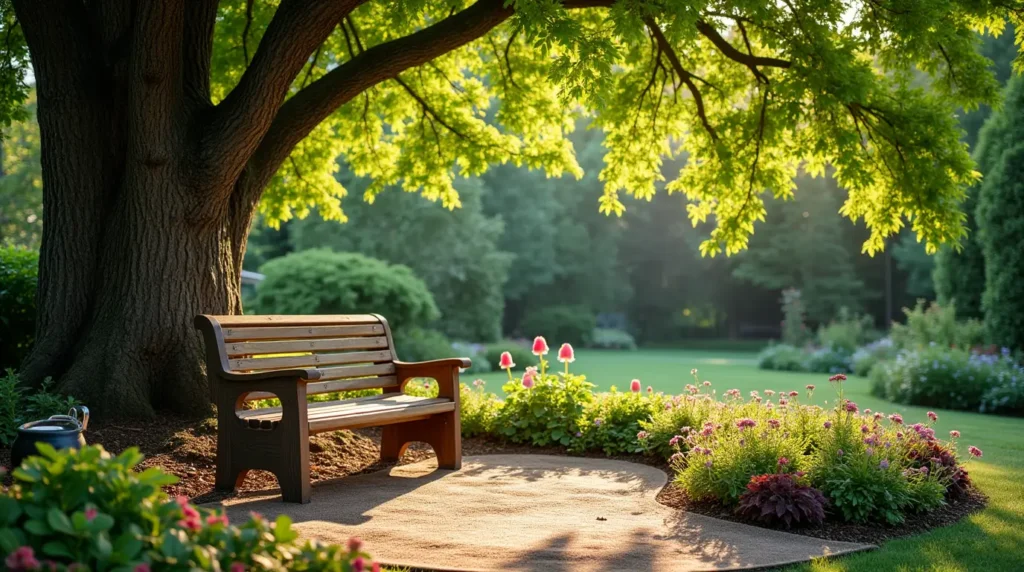
3.1. Under a Tree: A Shady Retreat
Placing your garden bench under a tree is a classic and timeless idea. The natural canopy provides shade, making it the perfect spot to escape the heat on sunny days. Imagine sitting on your bench, surrounded by the gentle rustling of leaves and the dappled sunlight filtering through the branches. This placement not only offers comfort but also creates a picturesque setting that feels like a hidden retreat. For added charm, consider planting flowers or adding mulch around the base of the tree to define the space.
3.2. By a Flower Bed: A Burst of Color and Fragrance
Positioning your garden bench next to a flower bed allows you to enjoy the beauty and fragrance of blooming plants. Whether it’s roses, lavender, or wildflowers, the vibrant colors and soothing scents will enhance your relaxation experience. This placement also makes your bench a focal point in the garden, drawing attention to both the seating area and the surrounding flora. To make the most of this setup, choose flowers that bloom at different times of the year for continuous visual appeal.
3.3. Near a Water Feature: Serenity by the Sound of Water
If your garden has a pond, fountain, or even a small birdbath, placing your garden bench nearby can create a serene and calming atmosphere. The sound of trickling water adds a soothing element to your outdoor space, making it an ideal spot for meditation, reading, or simply unwinding after a long day. Enhance the ambiance by adding aquatic plants or decorative stones around the water feature. This placement not only maximizes relaxation but also adds a touch of elegance to your garden.
3.4. Ideal for Compact Areas: Great for Patios or Balconies
Don’t have a large garden? No problem! A garden bench can work wonders on a patio or balcony, transforming even the smallest outdoor spaces into cozy retreats. Choose a compact bench that fits comfortably without overwhelming the area. Add potted plants, string lights, or a small side table to create a welcoming nook. This placement is perfect for urban gardens or apartments, offering a private outdoor escape where you can enjoy a cup of tea or watch the sunset.
3.5. Along a Garden Path: A Restful Stop Along the Way
Placing your garden bench along a garden path invites you to take a moment to pause and appreciate your surroundings. Whether it’s a winding stone path or a simple gravel walkway, a bench along the route provides a restful spot to sit and enjoy the journey. This placement is especially useful in larger gardens, where it can serve as a resting point while exploring. Surround the bench with low-growing plants or shrubs to create a natural, integrated look.
3.6. In a Secluded Corner: Your Private Sanctuary
For those seeking privacy and tranquility, placing your garden bench in a secluded corner of your garden can create a personal sanctuary. Use tall plants, trellises, or garden screens to enclose the area and make it feel more intimate. Add soft lighting, such as lanterns or fairy lights, to create a cozy atmosphere in the evenings. This placement is perfect for meditation, journaling, or simply enjoying some quiet time away from the hustle and bustle.
4. Accessorizing Your Garden Bench for Maximum Comfort
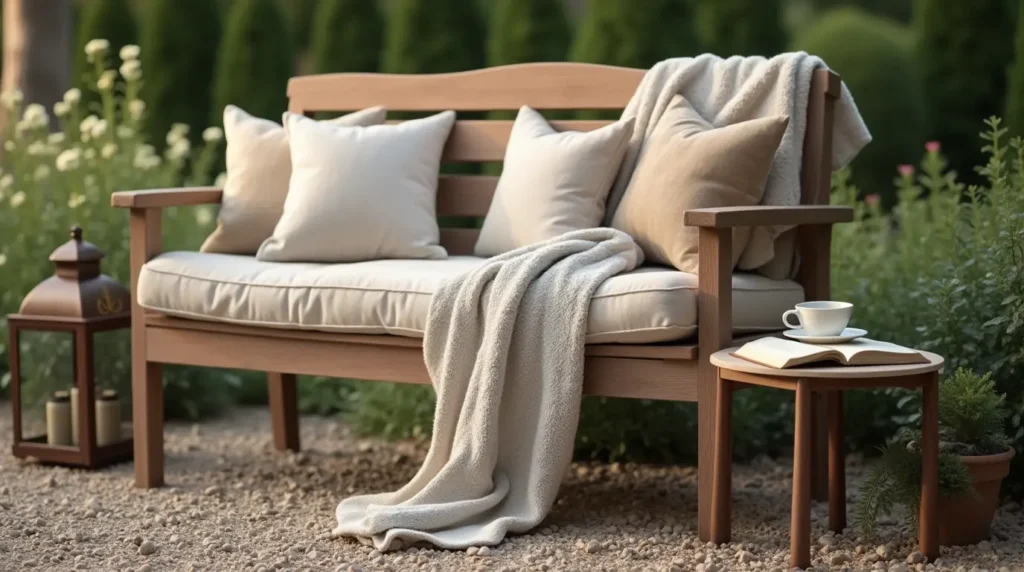
4.1. Cushions and Pillows: Soften Your Seat
One of the easiest ways to make your garden bench more comfortable is by adding cushions and pillows. Opt for weather-resistant fabrics like Sunbrella or polyester that can withstand rain, sun, and humidity. Choose colors and patterns that complement your garden’s aesthetic—bright hues for a playful look or neutral tones for a more serene vibe. Don’t forget to store cushions indoors during harsh weather to extend their lifespan. Pro Tip: Use cushion ties or Velcro straps to keep them securely in place, even on windy days.
4.2. Side Tables: Convenience at Your Fingertips
A small side table next to your garden bench can make a world of difference in terms of functionality. Use it to hold a cup of coffee, a book, or even a potted plant for added charm. Look for tables made from durable materials like metal, wood, or resin that match your bench’s style. For a cohesive look, choose a table that complements the design and color of your bench. If space is limited, consider a foldable or nesting table that can be easily stored when not in use.
4.3. Outdoor Throws and Blankets: Cozy Evenings Outdoors
For cooler evenings, keep an outdoor throw or blanket draped over your garden bench. Not only does it add a layer of warmth, but it also introduces texture and color to your outdoor space. Choose blankets made from weather-resistant materials like acrylic or fleece that are easy to clean and quick to dry. Fold the blanket neatly over the bench when not in use to create an inviting, cozy look. This simple addition can transform your bench into a year-round relaxation spot.
4.4. Decorative Elements: Add Personality and Charm
Accessorizing your garden bench with decorative elements can elevate its visual appeal and make it a true centerpiece in your garden. Consider these ideas:
- Lanterns or String Lights: Create a magical ambiance for evening relaxation.
- Potted Plants: Place small pots of flowers or herbs around the bench for a fresh, lively touch.
- Outdoor Rugs: Define the space and add a pop of color with a durable outdoor rug underneath the bench.
- Garden Art: Incorporate sculptures, wind chimes, or bird feeders to add personality and attract wildlife.
These decorative touches not only enhance comfort but also make your bench a reflection of your personal style.
4.5. Shade Solutions: Stay Cool and Protected
If your garden bench is placed in a sunny spot, consider adding shade solutions to make it more comfortable during hot days. Options include:
- Umbrellas: A sturdy outdoor umbrella can provide instant shade and can be adjusted as the sun moves.
- Pergolas or Arbors: Install a structure overhead and grow climbing plants like ivy or wisteria for natural shade.
- Shade Sails: Modern and stylish, these can be anchored to nearby trees or posts to create a cool retreat.
Shade not only enhances comfort but also protects your bench and accessories from sun damage.
4.6. Storage Solutions: Keep Essentials Handy
If your garden bench doesn’t have built-in storage, consider adding storage solutions to keep essentials like gardening tools, books, or outdoor accessories within reach. Options include:
- Storage Boxes: Place a decorative storage box underneath the bench to hold cushions, blankets, or tools.
- Hooks or Racks: Install hooks on the side of the bench to hang hats, bags, or small gardening tools.
- Bench with Storage: If you’re in the market for a new bench, consider one with a built-in storage compartment for added convenience.
These solutions help keep your outdoor space tidy and functional.
5. Maintaining Your Garden Bench for Longevity
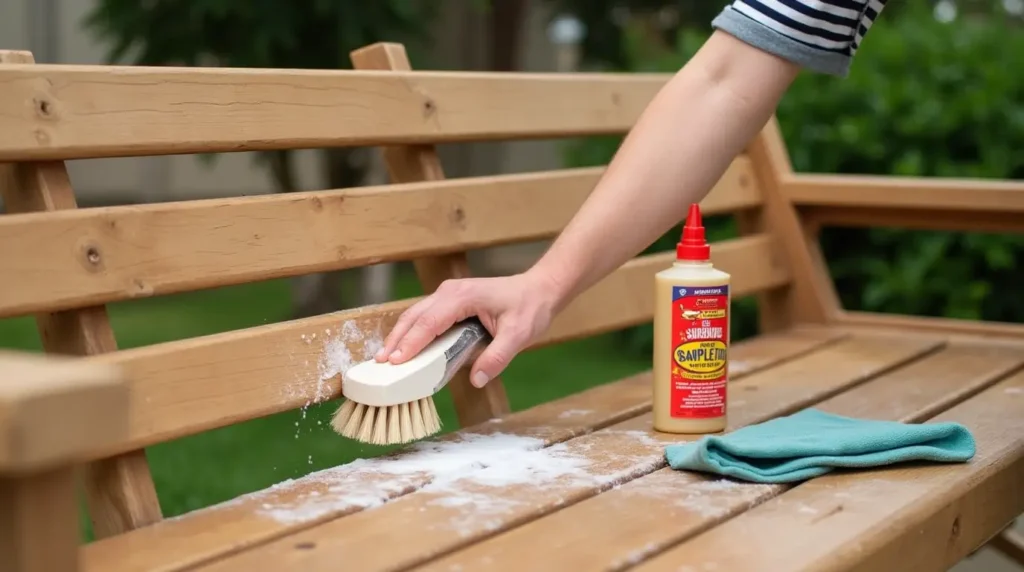
5.1. Regular Cleaning: Keep It Looking Fresh
Regular cleaning is essential to keep your garden bench in top condition. Dirt, pollen, and bird droppings can accumulate over time, leading to stains and damage. Here’s how to clean your bench effectively:
- Wooden Benches: Use a mild soap and water solution with a soft brush to scrub the surface. Steer clear of strong chemicals that can remove the wood’s natural oils.
- Metal Benches: Wipe down with a damp cloth and mild detergent. For rust spots, use a rust remover and a wire brush.
- Plastic Benches: Simply hose them down or wipe them with a soapy sponge.
- Concrete Benches: Use a pressure washer or a stiff brush with a mixture of water and vinegar to remove stains.
Pro Tip: Clean your bench at least once a month, or more frequently if it’s exposed to heavy use or harsh weather.
5.2. Protective Measures: Shield It from the Elements
Protecting your garden bench from the elements can significantly extend its lifespan. Consider these protective measures:
- Sealants and Stains: For wooden benches, apply a weather-resistant sealant or stain annually to prevent moisture damage and fading.
- Rust Prevention: For metal benches, use a rust-resistant spray or paint to protect against corrosion.
- Covers: Invest in a waterproof cover to shield your bench during rainy or snowy seasons. Make sure the cover is tightly secured to avoid any damage from wind.
- Indoor Storage: If possible, store your bench indoors during extreme weather conditions, especially in winter.
These steps will help your bench withstand the test of time and weather.
5.3. Seasonal Care: Adapt to Changing Weather
Different seasons bring different challenges for your garden bench. Here’s how to care for it year-round:
- Spring: Inspect for any winter damage, such as cracks or rust, and address it promptly. Reapply sealant or paint if necessary.
- Summer: Keep the bench clean and shaded to prevent sun damage. Check for signs of wear, such as fading or warping.
- Fall: Remove fallen leaves and debris to prevent moisture buildup and mold. Apply a fresh coat of protective sealant if needed.
- Winter: Cover the bench or store it indoors to protect it from snow, ice, and freezing temperatures.
Seasonal maintenance ensures your bench remains in great condition throughout the year.
5.4. DIY Repairs: Fix Minor Issues Promptly
Taking care of small problems quickly can stop them from turning into bigger issues. Here are some common repairs for your garden bench:
- Loose Screws or Bolts: Tighten them regularly to maintain stability.
- Scratches or Chips: Sand and touch up wooden benches with matching paint or stain. For metal benches, use touch-up paint to cover scratches.
- Wobbly Legs: Check for uneven ground and adjust the bench’s placement. If the legs are damaged, consider reinforcing them with brackets or replacing them entirely.
- Cushion Wear: Replace worn-out cushions or reupholster them with weather-resistant fabric.
DIY repairs are cost-effective and can significantly extend the life of your bench.
5.5. Preventative Maintenance: Stay Ahead of Problems
Preventative maintenance is key to ensuring your garden bench remains in excellent condition for years to come. Here’s how to stay ahead of potential issues:
- Regular Inspections: Check for signs of wear, such as cracks, rust, or loose parts, at least once a season.
- Lubrication: Apply lubricant to moving parts, such as hinges or folding mechanisms, to keep them functioning smoothly.
- Pest Control: Keep an eye out for pests like termites or ants that can damage wooden benches. Opt for natural repellents or seek advice from a professional if necessary.
- Proper Storage: If you’re not using the bench for an extended period, store it in a dry, covered area to prevent unnecessary exposure to the elements.
By taking these preventative steps, you can avoid costly repairs and replacements down the line.
FAQ
Q1: What’s the best material for a garden bench?
A: It depends! Wood is classic but needs maintenance, metal is durable but can rust, recycled plastic is low-maintenance, and concrete is sturdy and modern.
Q2: How do I protect my garden bench from weather?
A: Use weather-resistant sealants, rust-proof sprays, or waterproof covers. Store it indoors during harsh winters if possible.
Q3: Can I use a garden bench in a small space?
A: Yes! Choose compact or foldable benches and place them against walls or in corners to save space.
Q4: How do I make my garden bench cozy?
A: Add cushions, throws, potted plants, or lanterns. Use an outdoor rug and string lights for extra charm.
Q5: Are DIY garden benches worth it?
A: Absolutely! They’re cost-effective and customizable. Just use durable materials and follow proper plans.
Q6: How often should I clean my garden bench?
A: Clean it monthly and perform seasonal maintenance like tightening screws or reapplying sealants.
Q7: Can I leave my garden bench outside all year?
A: It’s best to cover or store it during extreme weather to prevent damage.
Q8: Where should I place my garden bench?
A: Under a tree, by a flower bed, near a water feature, on a patio, or along a garden path for a functional and beautiful spot.
Q9: What size garden bench should I choose?
A: Measure your space first. Compact benches work for small areas, while larger gardens can accommodate bigger designs.
Q10: What accessories work well with a garden bench?
A: Cushions, side tables, throws, potted plants, lanterns, and shade solutions like umbrellas or pergolas.

